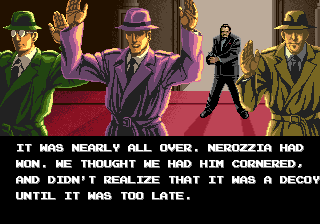
Huh? What decoy? No-one we fought on the last stage looked remotely like Nerozzia!
... Well, OK then. Let's just accept it and move on.
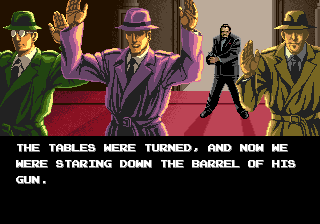
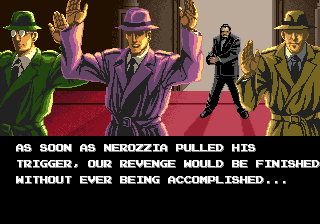
Looks like this is the end. Nice knowing you all, chaps.
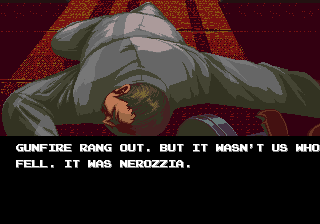
... !!!
The game is not over yet!
Who's come to save us in the nick of time?
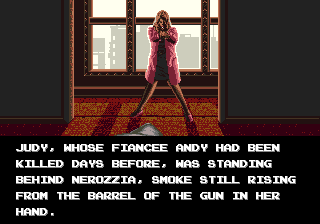
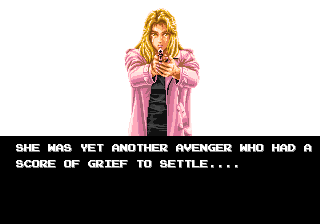
... Yes.
In case you forgot, Andy was the guy who sacrificed himself to save us in Stage 4.
What I love about this ending is that they nearly get the English just right...
Then fluff it up right at the end with 'ANOTHER AVENGER WHO HAD A SCORE OF GRIEF TO SETTLE'.
Bravo, Taito. Bravo.
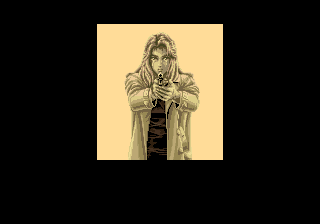
As is Gaming Hell tradition, here's the credits. Any interesting names in there?
There's a handful. For a start, long-time readers (anyone?) will spot Masaki Ogata in there- Director in this game, he was also mentioned in the hidden credits for The Fairyland Story. Next, Masami Kikuchi (Character Designer) has a ton of games to his name, usually as a character/art designer, including Aqua Jack, Elevator Action Returns and the arcade Darius games up to Gaiden. Finally, the sound is provided by two members of ZUNTATA, Yagisita and Sousukun. It's a shame that Crime City doesn't have any credits, as I'd love to compare them- they're the only games I can think of where police officers can crush out the crime by diving straight into people.
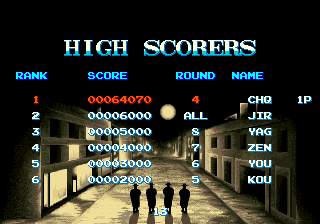
And here's another Gaming Hell tradition- HIGH SCORE TABLE TIME!!!
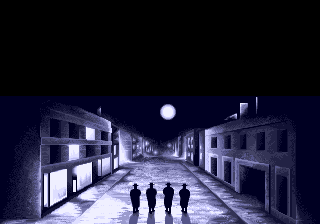
Our revenge is complete. That's Dead Connection finished.
OK, so why do I like Dead Connection so much? It's a combination of things. For a start, the mechanics are spot-on. Small, enclosed arenas with no scrolling of any kind is the sort of thing Robotron: 2084 and Smash T.V. did best, and this is Dead Connection's strength as well. Admittedly, things never get quite as chaotic as in those games (the total amount of gangsters you kill in Dead Connection is probably the kill count for the first level in Smash T.V.) but, unlike Bullet which wasted its twinstick controls by being too easy and letting you run away from fights, Dead Connection keeps you pressed against the wall. There's no real escape, especially in the open arenas like Stages 6 and 7, and that's a good thing. It's slightly more manageable than Smash T.V. mostly because it's at least half as long and goes at a much slower pace. but what it lacks it enemy numbers and frantic pacing it makes up for with the diving roll (which gives you a fighting chance of escaping a gun-fight alive, as does the health meter) and the environment.
Yes, the environmental destruction is what gives Dead Connection its edge- just like games like Cabal and Zombie Panic in Wonderland, there's a certain joy in just wrecking each stage, and the fact that it can be used to your advantage makes it that much more integral to the experience. All these put together make the game fun to run through more than once (only after playing more than once will you spot all the stuff you can do- I'm sure I even missed some) and the levels are just the right length. Mechanically, the two faults I can lodge against the game are that the Stage 3/4 boss takes far too long to kill (which can kill the flow of the game, albeit temporarily), and that the game suffers from slowdown in certain situations. This normally wouldn't be bad, but the two-player co-op mode really suffers from it, which is a damn shame as games like this benefit immensely from co-op play. Had this been on Taito's F3 hardware, like Elevator Action Returns, this probably wouldn't have been an issue! Really, though, these two things are the only bad things I have to say about the game.
The other thing, and this probably says something about what I look for in a video game, is that it is ridiculous. Not as much as Smash T.V., again, but Dead Connection is full of all the incredibly silly stuff that I love about video games. The film-noir plot which doesn't really make sense but makes for some hilarious cut-scenes. The voice samples that are probably some of the finest to ever come out of an arcade cab's speakers. Diving head-first into gangsters and killing them. Blowing up a gangster's garden party just because you can. It's not a parody or send-up either- it feels like it's genuine, which makes it all even funnier. This over-the-top nature ties back into the environmental mechanics too, as while it does peter out a bit by Stage 7, all of them have something special about them (my favourite detail is a toss-up between the streakers in Stage 1 and destroying the water fountain in Stage 7), so it's the detail in destruction and the satisfying mechanics that make Dead Connection a winner for me. We can only guess as to why it fell into obscurity- arcade-history.com has something vague about it being unpopular in Japan because of its theme, and the game never received any home conversions, not even in those PS2 Taito collections. I'm guessing because with all the stuff that goes on, a port to the home systems at the time would've been tough... Like many arcade-only games, though, we have MAME to thank for keeping the game alive.

I guess I'm easily amused, but if you really want to stick it to some mobsters, play Dead Connection.
And now, it's that time, folks!
EXTENDED PLAY!
Dead Connection Unofficial Soundtrack
Dead Connection Sound Pack
Most likely due to its unpopularity, Dead Connection was never given a full official soundtrack, which is unusual as almost every other Taito game does. As far as I can tell, the only official release of its music is on cassette- ZUNTATA RARE SELECTION, which seems to only have two songs anyway (Stage 1 and Character Select/Name Entry) This is a shame, as the music is incredible, and half of it seems to go on for so long that you'll never hear it all in-game- the intro in particular cuts-off halfway through, as soon as the High Score table appears. So, we've ripped it all for you. We didn't bother giving the songs fancy names (as tempting as it was to call the Boss theme 'DON'T RETURN THEM ALIVE'), just the parts of the game they appear in. Also, those of you who listened along to the amazing voice files scattered across this article will find all of them- and more- in the Sound Pack. Use them as alarm sounds on your phone, or perhaps as your Incoming Tweet alert sound on clients that let you change it, like Janetter, to make your life more exciting.
Finally, just in the interests of leaving no stone unturned:
As far as we could tell, there's no gameplay differences between the World and Japan versions.
The in-game speech is still in English, but all the text has been translated...
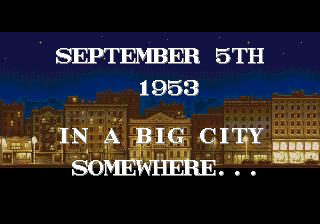
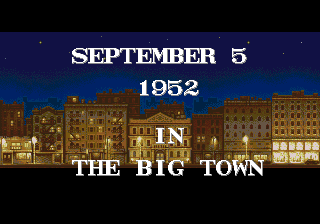
... Except this from the intro. World version's on the left, Japanese on the right.
The change of the year here is important- this intro takes place in 1952, and the journals in the Japanese version specify the year 1953.
So, Christine was murdered roughly a year before the game's events begin...
The World version's journals don't specify a year, but if it was 1953, then Christine would've died after the game's events.
And even for a Taito game, that wouldn't make any sense.
[In-depth discussion of plot canon in an article on Dead Connection. Blimey. Be right back, getting you a t-shirt made that reads 'WORLD'S BIGGEST NERD'
- Ed]
Well, that was quite a ride, no? Hopefully, this has shown you that in the world of arcades, Taito is the supreme law.
WELL, LET'S GO FOR A KILL TIME ON THE INDEX











